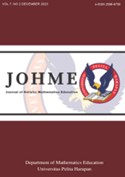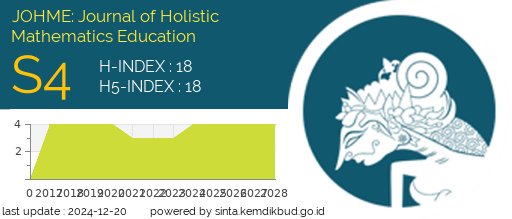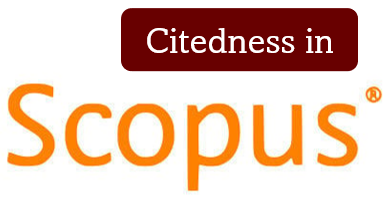STUDENTS’ WAYS OF UNDERSTANDING AND THINKING BASED ON HAREL’S THEORY IN SOLVING SET PROBLEMS
DOI:
https://doi.org/10.19166/johme.v7i2.7422Λέξεις-κλειδιά:
Harel's theory, set problems, set theory, ways of thinking, ways of understandingΠερίληψη
Ways of thinking (WoT) and Ways of Understanding (WoU) are important in learning mathematics. This study aims to analyze the characteristics of students' ways of thinking (WoT) and ways of understanding (WoU) when solving set problems. The participants in this study were 27 students in the seventh grade at a private secondary school in Bandung. Four students were selected as research subjects. The research method used is qualitative research. The instruments in this study were the researchers and the set material problem-solving test. The data collection technique in this study was carried out through a test, interviews, and documentation. The research results showed that the majority of students who were correct in their way of thinking were also correct in their way of understanding. And the majority of students who have the incorrect way of thinking also have the incorrect way of understanding. The study's results also indicated that the majority of student errors stemmed from a lack of proper understanding of the question and the concept of set theory.
BAHASA INDONESIA ABSTRACT: Cara berpikir dan cara memahami merupakan hal yang penting dalam belajar matematika. Penelitian ini bertujuan untuk menganalisis karakteristik cara berpikir dan cara memahami siswa dalam menyelesaikan masalah himpunan. Partisipan pada penelitian ini adalah siswa kelas VII di salah satu SMP Swasta di Bandung berjumlah 27 partisipan. Empat siswa dipilih sebagai subjek penelitian. Metode penelitian yang digunakan adalah penelitian kualitatif. Instrumen dalam penelitian ini adalah peneliti sendiri dan tes pemecahan masalah materi himpunan. Teknik pengumpulan data dalam penelitian ini dilakukan dengan memberikan tes, wawancara dan dokumentasi. Hasil penelitian menunjukkan bahwa mayoritas siswa yang memiliki cara berpikir yang benar juga memiliki cara pemahaman yang benar. Dan mayoritas siswa yang memiliki cara berpikir yang salah juga memiliki cara pemahaman yang salah. Hasil penelitian juga menunjukkan bahwa sebagian besar kesalahan siswa disebabkan karena siswa kurang memahami soal dan konsep materi himpunan dengan baik.
Αναφορές
Aulia, N. T., Ariyanto, L., & Murtianto, Y. H. (2022). Kesulitan belajar siswa pada penguasaan konsep himpunan berdasarkan klasifikasi kecerdasan emosional, Imajiner: Jurnal Matematika dan Pendidikan Matematika, 4(5), 442-453. Retrieved from https://journal.upgris.ac.id/index.php/imajiner/article/view/11430/6134
Harel, G. (2008). A DNR perspective on mathematics curriculum and instruction. Part II: With reference to teacher’s knowledge base. ZDM: International Journal on Mathematics Education, 40(5), 893-907. https://doi.org/10.1007/s11858-008-0146-4
Harel, G. (2008). DNR perspective on mathematics curriculum and instruction, Part I: Focus on proving. ZDM: International Journal on Mathematics Education, 40(3), 487-500. https://doi.org/10.1007/s11858-008-0104-1
Harel, G. (2013). DNR-based curricula: The case of complex numbers. Journal of Humanistic Mathematics, 3(2), 2-61. https://doi.org/10.5642/jhummath.201302.03
Hester, J. (2021). Building relationships and resolving conflicts: Infusing critical thinking into workplace practices. The Journal of Values-Based Leadership, 14(1), 1-17. https://doi.org/10.22543/0733.141.1353
Jayanti, W. E., Usodo, B., & Subanti, S. (2018). Interference thinking in constructing students’ knowledge to solve mathematical problems. Journal of Physics: Conference Series, 1008(1), 1-10. https://doi.org/10.1088/1742-6596/1008/1/012069
Marufi, M., Ilyas, M., Ikram, M., Rosidah, R., & Kaewhanam, P. (2022). Exploration of high school students’ reasoning in solving trigonometric function problems. Jurnal Pendidikan Matematika, 13(2), 231-249. Retrieved from http://ejournal.radenintan.ac.id/index.php/al-jabar/article/view/12972/5761
Nggaba, M. E. (2020). Analysis of students critical thinking ability in solving trigonometric problems. Journal of Physics: Conference Series, 1521(3), 1-8. https://doi.org/10.1088/1742-6596/1521/3/032023
Nurhasanah, H., Turmudi, & Jupri, A. (2021). Karakteristik ways of thinking (WoT) dan ways of understanding (WoU) siswa berdasarkan teori Harel. Journal of Authentic Research on Mathematics Education (JARME), 3(1), 105-113. Retrieved from https://jurnal.unsil.ac.id/index.php/jarme/article/view/2449/1588
Ratnasari, S., & Setiawan, W. (2019). Analisis kesulitan belajar siswa pada materi himpunan. Journal on Education, 1(2), 473-479. Retrieved from https://jonedu.org/index.php/joe/article/view/94/76
Samo, D. D., Darhim, D., & Kartasasmita, B. (2017). Developing contextual mathematical thinking learning model to enhance higher-order thinking ability for middle school students. International Education Studies, 10(12), 17-29. https://doi.org/10.5539/ies.v10n12p17
Setyaningsih, N., Juniati, D., & Suwarsono. (2018). Student’s scheme in solving mathematics problems. Journal of Physics: Conference Series, 974(1), 1-9. https://doi.org/10.1088/1742-6596/974/1/012012
Sundari, R., Andhany, E., & Dur, S. (2019). Analisis kesulitan siswa dalam menyelesaikan soal cerita materi himpunan ditinjau dari tahapan Newman. AXIOM: Jurnal Pendidikan dan Matematika, 8(2), 187-194. https://doi.org/10.30821/axiom.v8i2.6338
Walingkas, D., & Sulangi, V. R. (2022). Kesalahan siswa menyelesaikan masalah pada materi himpunan: Studi kualitatif pada siswa SMP Negeri 1 Tompaso Baru. Jurnal Pendidikan, Bahasa, dan Budaya, 1(4), 130-141. https://doi.org/10.55606/jpbb.v1i1.853
Walker, W. (2007). Ethical considerations in phenomenological research. Nurse Researcher, 14(3), 36-45. https://doi.org/10.7748/nr2007.04.14.3.36.c6031
Watson, A., & Harel, G. (2013). The role of teachers’ knowledge of functions in their teaching: A conceptual approach with illustrations from two cases. Canadian Journal of Science, Mathematics and Technology Education, 13(2), 154-168. https://doi.org/10.1080/14926156.2013.784826Λήψεις
Δημοσιευμένα
Πώς να δημιουργήσετε Αναφορές
Τεύχος
Ενότητα
Άδεια
Authors who publish with this journal agree to the following terms:
1) Authors retain copyright and grant the journal right of first publication with the work simultaneously licensed under a Creative Commons Attribution License (CC-BY-SA 4.0) that allows others to share the work with an acknowledgement of the work's authorship and initial publication in this journal.
2) Authors are able to enter into separate, additional contractual arrangements for the non-exclusive distribution of the journal's published version of the work (e.g., post it to an institutional repository or publish it in a book), with an acknowledgement of its initial publication in this journal.
3) Authors are permitted and encouraged to post their work online (e.g., in institutional repositories or on their website). The final published PDF should be used and bibliographic details that credit the publication in this journal should be included.”










